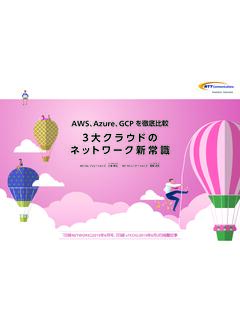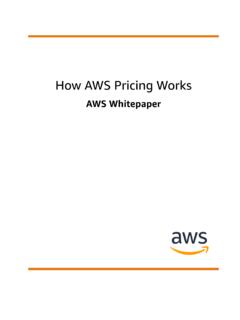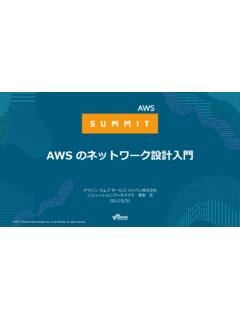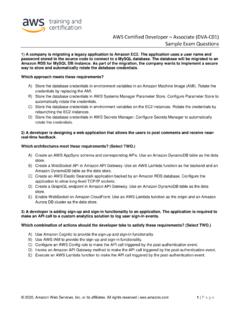Transcription of ARCHIVED: How AWS Pricing Works: AWS Pricing Overview
1 How AWS Pricing Works June 2018 (Please consult for the latest version of this paper) Amazon Web Services How AWS Pricing Works June 2018 Page 2 of 22 Table of Contents Introduction .. 4 Key Principles .. 4 Understand the fundamentals of Pricing .. 4 Start early with cost optimization .. 4 Maximize the power of flexibility .. 5 Use the right Pricing model for the job .. 5 Get started with the AWS Free Tier .. 6 Pricing details for individual services .. 6 Amazon Elastic Compute Cloud (Amazon EC2).
2 6 AWS 9 Amazon Elastic Block Store (Amazon EBS) .. 10 Amazon Simple Storage Service (Amazon S3) .. 11 Amazon S3 Glacier .. 11 AWS Snowball .. 12 Amazon RDS .. 14 Amazon DynamoDB .. 15 Amazon CloudFront .. 16 Optimizing costs with reservations .. 17 Amazon EC2 Reserved Instances .. 17 Amazon DynamoDB Reserved Capacity .. 18 Amazon ElastiCache Reserved Nodes .. 18 Amazon RDS RIs .. 19 Amazon Redshift Reserved Nodes .. 19 Conclusion .. 19 Resources .. 20 Cost calculation example .. 21 Amazon Web Services How AWS Pricing Works June 2018 Page 3 of 22 2018, Amazon Web Services, Inc.
3 Or its affiliates. All rights reserved. Notices This document is provided for informational purposes only. It represents AWS s current product offerings and practices as of the date of issue of this document, which are subject to change without notice. Customers are responsible for making their own independent assessment of the information in this document and any use of AWS s products or services, each of which is provided as is without warranty of any kind, whether express or implied. This document does not create any warranties, representations, contractual commitments, conditions or assurances from AWS, its affiliates, suppliers or licensors.
4 The responsibilities and liabilities of AWS to its customers are controlled by AWS agreements, and this document is not part of, nor does it modify, any agreement between AWS and its Web Services How AWS Pricing Works June 2018 Page 4 of 22 Introduction Amazon Web Services (AWS) helps you move faster, reduce IT costs, and attain global scale through a broad set of global compute, storage, database , analytics, application, and deployment services. One of the main benefits of cloud services is the ability it gives you to optimize costs to match your needs, even as those needs change.
5 AWS offers on-demand, pay-as-you-go, and reservation-based payment models, enabling you to obtain the best return on your investment for each specific use case. AWS services do not have complex dependencies or licensing requirements, so you can get exactly what you need to build innovative, cost-effective solutions using the latest technology. In this whitepaper, we ll provide an Overview of how AWS Pricing works across some of our most widely used services. The latest Pricing information for each AWS service is available at Key Principles While Pricing models vary across services, it s worthwhile to review key principles and best practices that are broadly applicable.
6 Understand the fundamentals of Pricing There are three fundamental drivers of cost with AWS: compute, storage, and outbound data transfer. These characteristics vary somewhat, depending on the AWS product and Pricing model you choose. In most cases, there is no charge for inbound data transfer or for data transfer between other AWS services within the same region. There are some exceptions, so be sure to verify data transfer rates before beginning. Outbound data transfer is aggregated across services and then charged at the outbound data transfer rate.
7 This charge appears on the monthly statement as AWS Data Transfer Out. The more data you transfer, the less you pay per GB. For compute resources, you pay hourly from the time you launch a resource until the time you terminate it, unless you have made a reservation for which the cost is agreed upon beforehand. For data storage and transfer, you typically pay per GB. Except as otherwise noted, our prices are exclusive of applicable taxes and duties, including VAT and sales tax. For customers with a Japanese billing address, use of AWS is subject to Japanese Consumption Tax.
8 Learn more. Start early with cost optimization Adopting cloud services is not just a technical evolution. It also requires changes to how organizations operate. As you move from IT being treated as a capital investment that happens periodically to a world where Pricing is closely tied to efficient use of resources, it pays to understand what drives cloud Pricing so you can build a strategy for optimizing it. Amazon Web Services How AWS Pricing Works June 2018 Page 5 of 22 When it comes to understanding Pricing and optimizing your costs, it s never too early to start.
9 It s easiest to put cost visibility and control mechanisms in place before the environment grows large and complex. Managing cost-effectively from the start ensures that managing cloud investments doesn t become an obstruction as you grow and scale. Learn more at the AWS Cost Optimization page. Maximize the power of flexibility AWS services are priced independently and transparently, so you can choose and pay for exactly what you need and no more. No minimum commitments or long-term contracts are required unless you choose to save money through a reservation model.
10 By paying for services on an as-needed basis, you can redirect your focus to innovation and invention, reducing procurement complexity and enabling your business to be fully elastic. One of the key advantages of cloud-based resources is that you don t pay for them when they re not running. By turning off instances you don t use, you can reduce costs by 70 percent or more compared to using them 24/7. This enables you to be cost-efficient and, at the same time, have all the power you need when workloads are active. Use the right Pricing model for the job AWS offers several Pricing models depending on product.
















